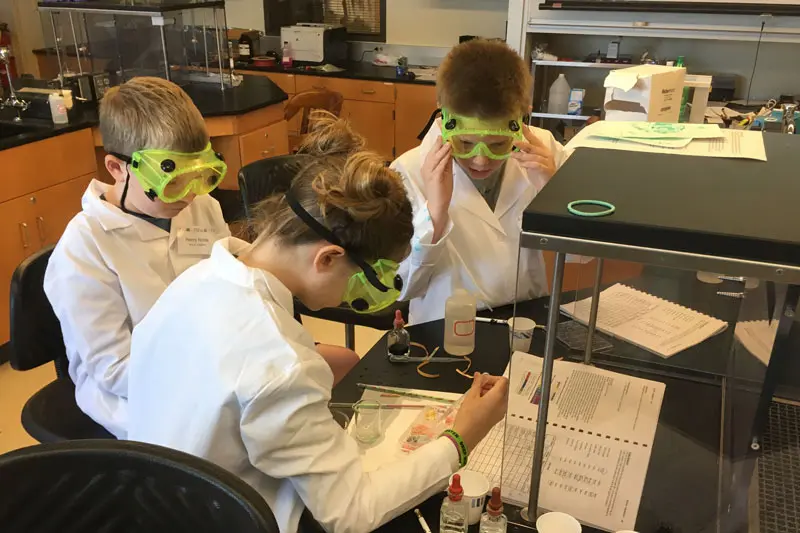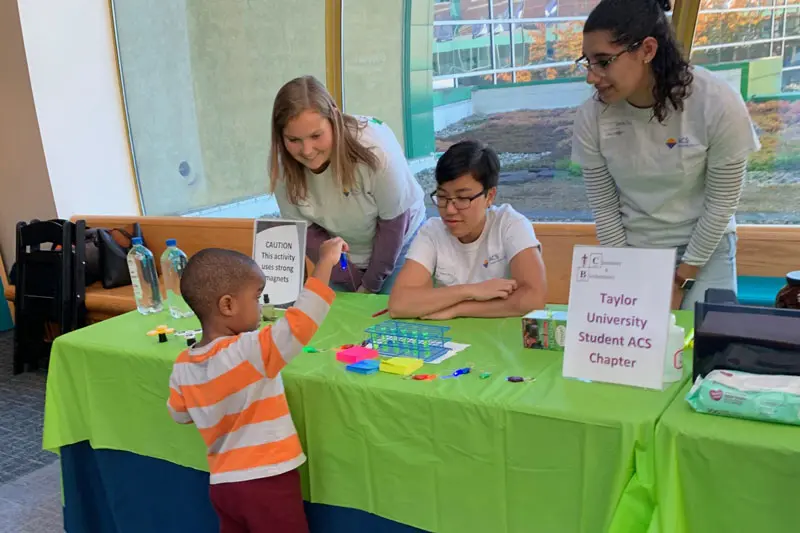*Images taken pre-pandemic.*
Taylor’s STEM majors are dedicated to learning about the world around them and pushing the limits of their own abilities. They also want to share that knowledge with those around them, especially with the next generation of scientists and researchers. In the Chemistry department, that means leading activities in museums, collaborating with local schools, and even setting up their own science camps.
Reaching Kids Through Chemistry Day
For many years, the Chemistry department has volunteered at the Indianapolis Children’s Museum’s Chemistry Day. This annual event is an opportunity for young children to learn about science through demonstrations, hands-on activities, and displays.
Taylor students lead demonstrations about the different types of light and the acidity and basicity of common household solutions. For some kids, these demonstrations are their first time seeing what chemistry can do.

“My favorite memory was when a toddler sincerely asked me, ‘Is that magic?’ when a pH paper turned red,” said senior Melissa Copeland.
These interactions allow students to share their passion with children who could someday grow up and follow in their footsteps. Most kids don’t realize how prevalent chemistry is in their surroundings, so Taylor students get the opportunity to introduce them to its prevalence in their daily lives.
Working with Local Schools
The Chemistry department has also spent several years working with local schools to fuel students’ love of chemistry and prepare them for more advanced concepts. Students interested in a future in education have led demonstrations and labs with a variety of age groups.
“The more interesting one was when we brought a Spec20 (spectrometer) over to work on calibration curves and concentration,” Chemistry Education major Emily Knight said. “That’s a piece of equipment that’s less common in high schools, so it was fun to give some high schoolers experience with it.”
While current events make traveling difficult, the department is still finding other ways to help the community. They have been developing demonstrations they could do over Zoom with younger students and are arranging to help in more socially-distanced ways like reorganizing stockrooms to be safer for students and teachers. These interactions are important not just to the students learning chemistry, but the chemistry majors who help teach them.
“Spending time with kids is a really great way to remember why you enjoy science, or whatever your passion is!” Knight said.
Starting a Camp of Their Own
In the summer of 2019, Knight also worked with Associate Professor of Chemistry Patricia Stan to start a summer science camp for middle schoolers in the local community. Knight spent the summer developing outreach activities for the Chemistry department to use when visiting local schools or donating materials to teachers.
Using the materials Knight organized, the participants spent a week doing everything from practicing forensic science to solve a mock crime scene to using chemical reactions to launch rockets. Stan and Knight took turns running the events, which gave Knight plenty of experience and reminders about why she plans on becoming a chemistry and physics teacher.
“I loved working with students who wanted to know more,” Knight said. “In camp, there was a student who just asked questions about every activity and took notes on what we were saying. So, generally, seeing people excited about the science behind things is great!”
Building Their Own Community
As much as the Chemistry department focuses on helping the surrounding community, its students and professors are equally invested in connecting with each other. The chemistry cabinet is a part of the American Chemical Society, one of the world’s largest scientific societies. This connection provides students with unique opportunities and connections they couldn’t find on their own.
“Before COVID, the professors would bring in a potluck dinner for the students and the chemistry and biochemistry department (along with chemistry minors) would gather for a meal together,” said Kendra Russell, president of the chemistry cabinet. “During the meal, there is usually some sort of presentation. We have brought in speakers from large chemical companies such as Elanco and Abbot Labs. Speakers have informed students of several opportunities in the professional field, but have also encouraged them to seek out different research opportunities.”
The department also organizes ways to connect with students on campus through events like Desserts and Demos. Every other year, chemistry students prepare demonstrations to share their knowledge of chemistry with their peers over snacks.
Thanks to these events, the department has made strong connections, both inside and out. Their bonds have reached beyond only the chemical as they engage with science in community.
Interested in sharing your love for chemistry? Learn more about the Chemistry department here.


